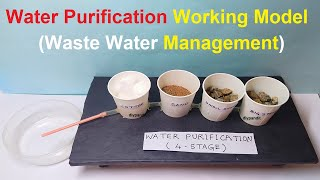1. What is the purpose of the sand in the water purification process?
- Answer: Sand is used in the water purification process to filter out larger particles and impurities present in the water.

2. How does the sand filtration stage contribute to improving water quality?
- Answer: The sand filtration stage traps suspended particles and debris, enhancing water clarity and removing larger impurities.
3. Why is gravel used in the water purification process?
- Answer: Gravel is employed to provide additional filtration in the water treatment process. It further helps in the removal of smaller particles and acts as a support for the sand layer.
4. What role does the gravel layer play in the purification process?
- Answer: The gravel layer acts as a coarse filter, preventing the sand layer from clogging and allowing for better water flow during the filtration process.
5. How does the four-stage water purification process involving sand and gravel begin?
- Answer: The process typically begins with raw water passing through a layer of gravel to remove larger debris and sediment.
6. What is the function of the cotton layer in the water purification process?
- Answer: The cotton layer acts as a finer filter, capturing smaller particles that may have passed through the sand and gravel layers.
7. How does the cotton layer contribute to water quality improvement?
- Answer: The cotton layer enhances water purity by trapping finer impurities, including some bacteria and microorganisms, that may not be effectively removed by sand and gravel alone.
8. Why is it important to have multiple filtration stages in water purification?
- Answer: Multiple filtration stages, such as sand, gravel, and cotton, are essential to ensure a comprehensive removal of impurities at different sizes, leading to cleaner and safer water.
9. Can you describe the flow of water through the sand and gravel layers in the purification process?
- Answer: Water flows through the gravel layer first, removing larger particles. It then passes through the sand layer, trapping smaller particles, and finally through the cotton layer for finer filtration.
10. How does the four-stage water purification process contribute to making water safe for drinking?
Answer: The process effectively removes various impurities, including sediments and microorganisms, making the water safer for consumption by reducing the risk of waterborne diseases.
11. What is the significance of the order of layers in the four-stage purification process?
Answer: The order is designed to progressively filter water from larger to smaller particles, ensuring efficient removal of impurities and preventing clogging of finer layers.
12. How often should the sand and gravel layers be maintained or replaced in a water purification system?
Answer: The maintenance frequency depends on factors like water quality and usage. Regular inspection is recommended, and replacement may be necessary if the layers become ineffective.
13. How can communities implement a simple four-stage water purification system using sand, gravel, and cotton?
Answer: Communities can construct a filtration unit with layers of gravel, sand, and cotton arranged in a container. Raw water can be poured through the layers, and the filtered water collected.
14. Why is it essential to use clean and uncontaminated sand in the purification process?
Answer: Clean sand is crucial to prevent introducing new impurities into the water. Contaminated sand could compromise the effectiveness of the filtration process.
15. Can the four-stage water purification process be adapted for household use?
Answer: Yes, the principles of the four-stage process can be adapted for household water purification systems, especially in areas where centralized treatment is unavailable.
16. How does the four-stage purification process contribute to sustainable water management? – Answer: The process promotes sustainability by providing a cost-effective and energy-efficient method for communities to purify water locally, reducing reliance on centralized water treatment.
17. What challenges might communities face in implementing the four-stage purification process?
Answer: Challenges include obtaining clean and appropriate materials, ensuring proper maintenance, and addressing community awareness to encourage the adoption of this purification method.
18. How does the four-stage purification process compare to other water treatment methods in terms of simplicity? – Answer: The four-stage process is relatively simple and can be implemented with locally available materials, making it a practical option for communities with limited resources.
19. What is the role of the community in maintaining and sustaining the four-stage purification system?
Answer: Communities play a crucial role in maintaining the system by regularly inspecting and cleaning the layers, as well as raising awareness about the importance of clean water.
20. How can schools incorporate the concept of a four-stage water purification system into science education?
Answer: Schools can use practical demonstrations, models, and experiments to teach students about the principles and importance of water purification, emphasizing the four-stage process.
21. Why is it important to adapt water purification methods based on the specific needs and resources of a community?
Answer: Adapting methods ensures that water purification solutions are feasible, sustainable, and tailored to the unique challenges and resources of each community.
22. What are some limitations of the four-stage water purification process?
Answer: Limitations include the inability to remove certain chemical contaminants and the need for regular maintenance to prevent clogging of the filtration layers.
23. Can the four-stage water purification process be combined with other treatment methods for improved effectiveness?
Answer: Yes, it can be combined with other methods like chlorination or UV treatment for enhanced water purification, depending on the specific water quality challenges.
24. How does public awareness contribute to the success of community-based water purification initiatives?
Answer: Public awareness fosters community engagement, encourages proper use and maintenance of purification systems, and promotes a culture of valuing clean and safe water.
25. In what ways can students actively contribute to community-based water purification projects? – Answer: Students can contribute by participating in awareness campaigns, conducting water quality tests, assisting in system maintenance, and exploring innovative solutions to improve water access and purification.

